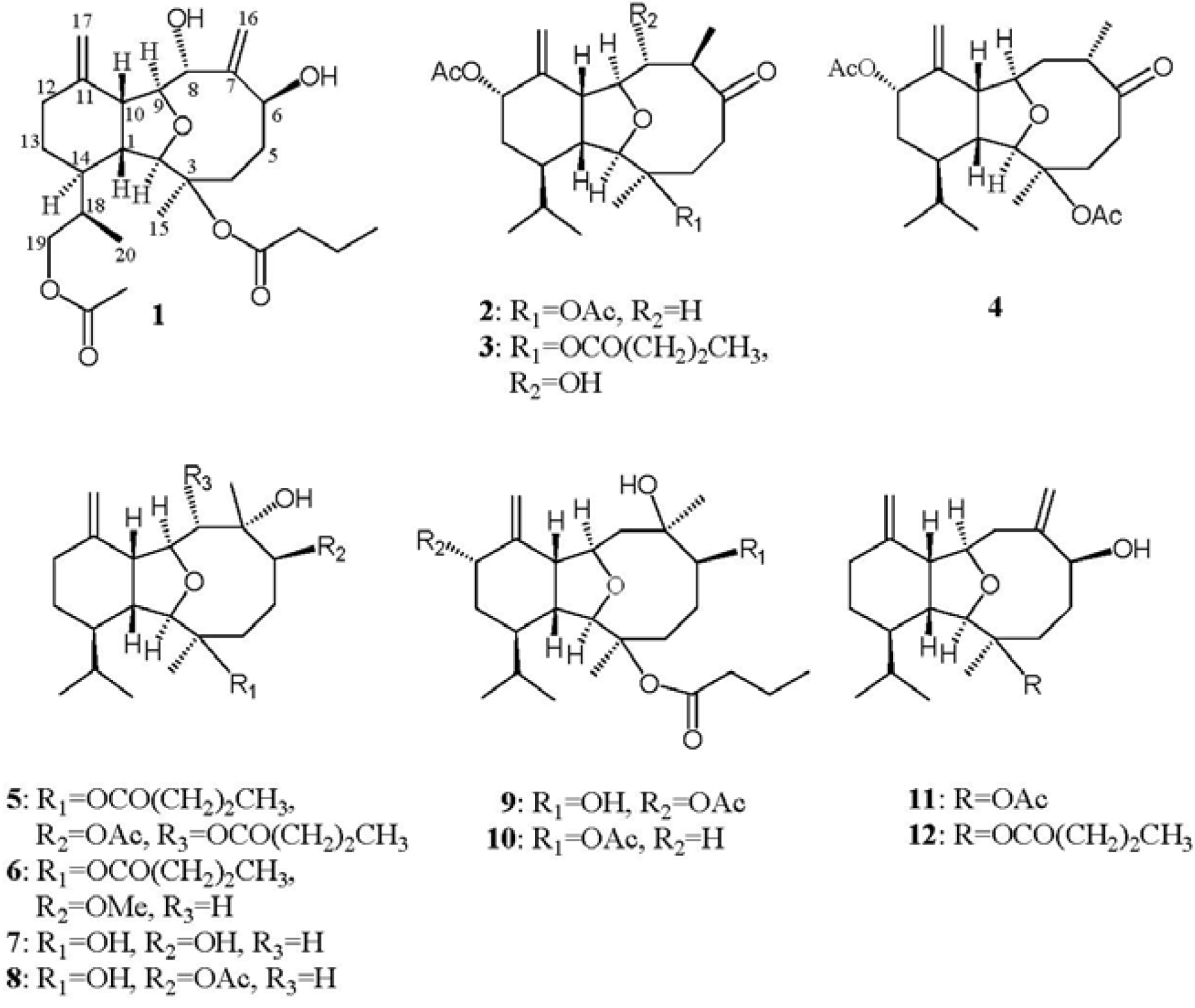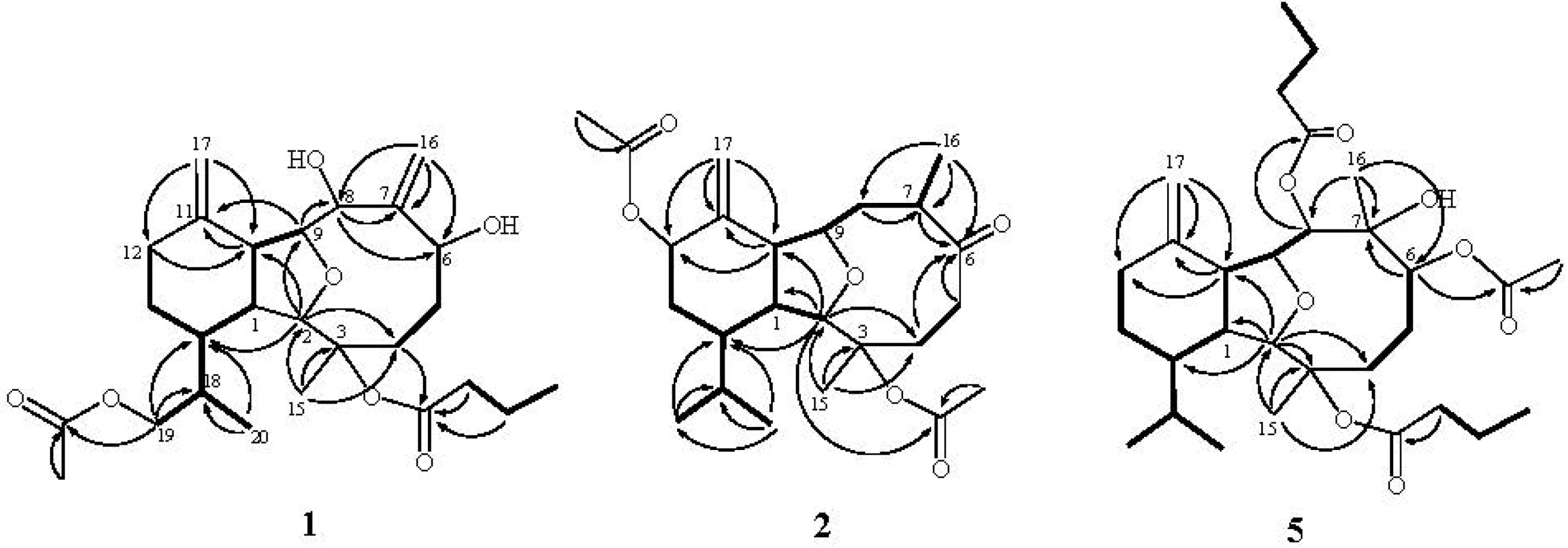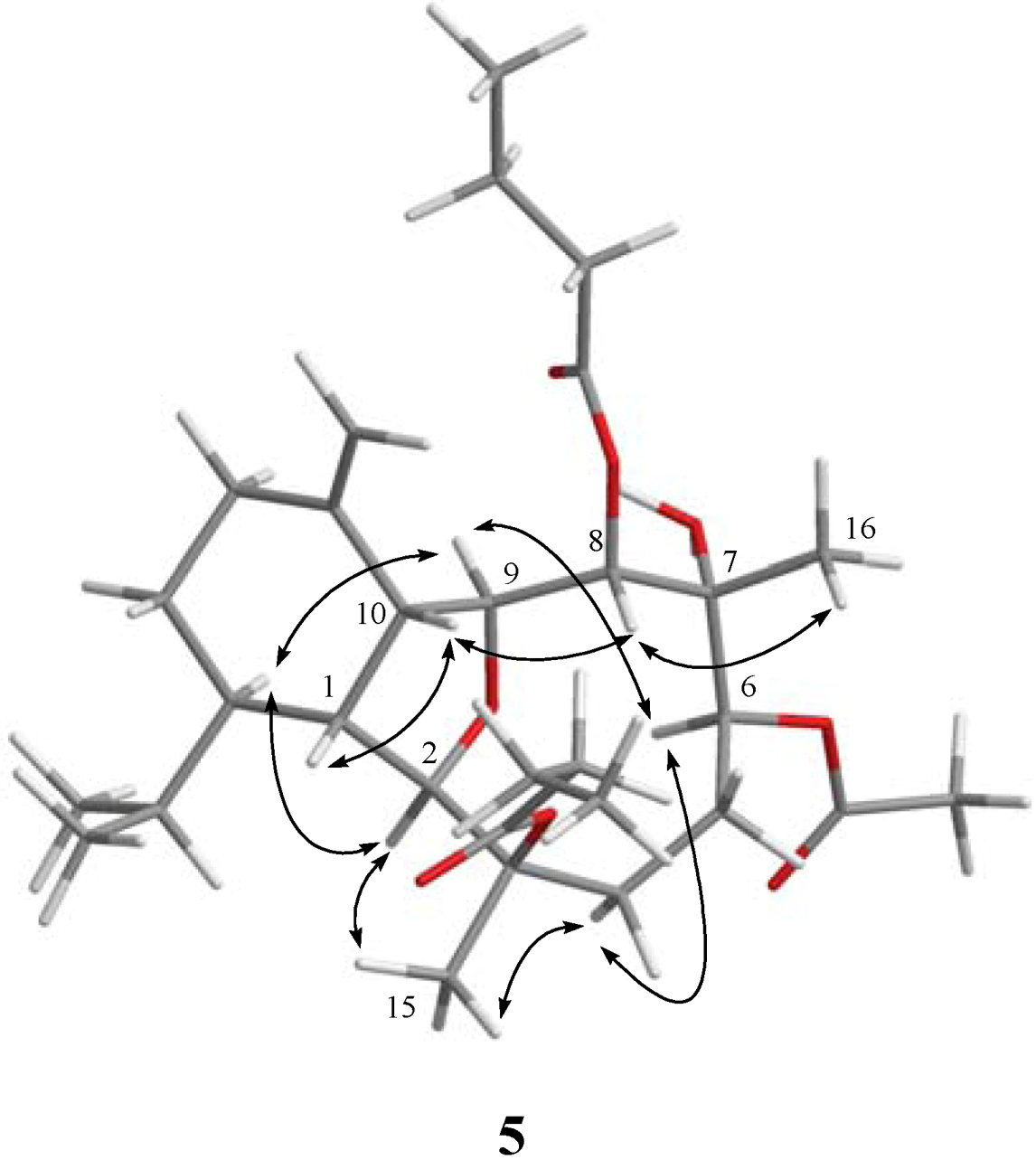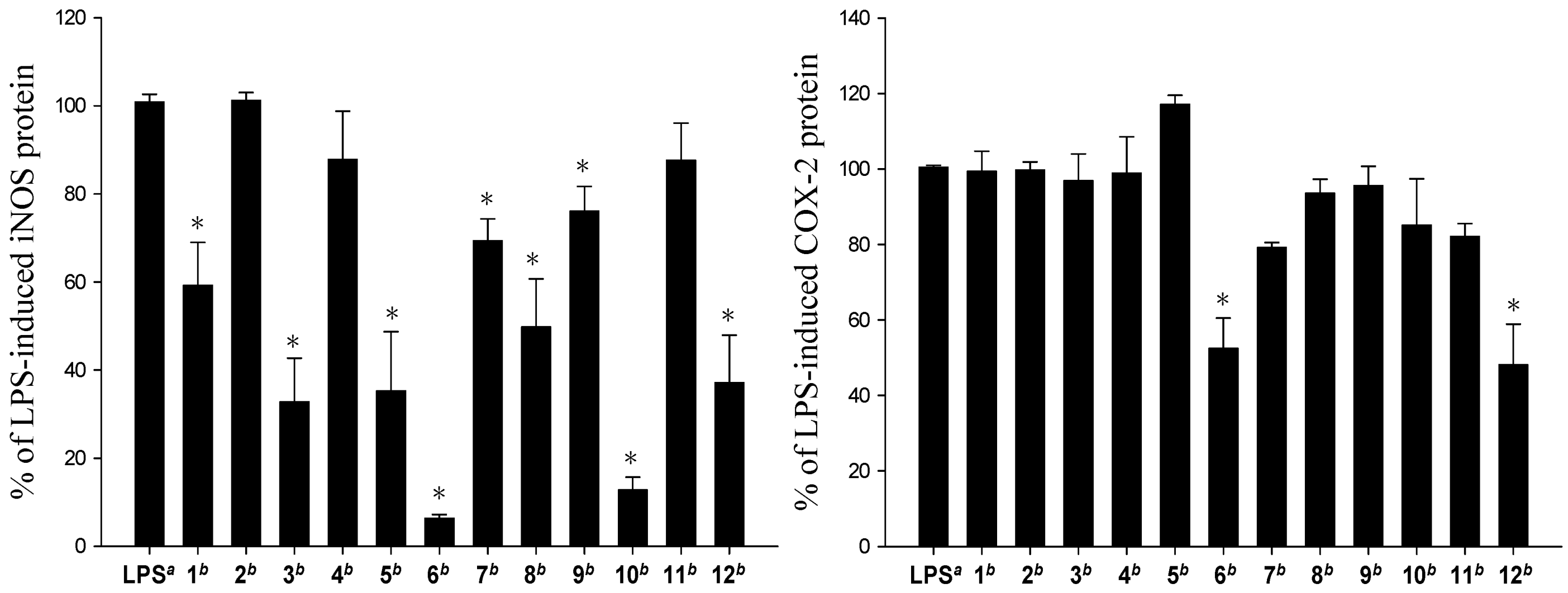Cytotoxic and Anti-Inflammatory Eunicellin-Based Diterpenoids from the Soft Coral Cladiella krempfi
Abstract
:1. Introduction

2. Results and Discussion
| C | 1 a | 2 a | 3 b | 4 b | 5 a |
|---|---|---|---|---|---|
| 1 | 43.3, CH c | 45.8, CH | 44.7, CH | 44.9, CH | 46.6, CH |
| 2 | 91.4, CH | 90.6, CH | 90.9, CH | 90.8, CH | 92.6, CH |
| 3 | 84.4, C | 84.7, C | 84.2, C | 84.6, C | 85.6, C |
| 4 | 28.4, CH2 | 33.2, CH2 | 33.2, CH2 | 32.6, CH2 | 35.8, CH2 |
| 5 | 35.3, CH2 | 30.2, CH2 | 29.7, CH2 | 38.3, CH2 | 28.5, CH2 |
| 6 | 66.9, CH | 214.8, C | 217.0, C | 213.4, C | 82.3, CH |
| 7 | 152.2, C | 48.3, CH | 40.7, CH | 40.6, CH | 78.0, C |
| 8 | 77.3, CH | 42.4, CH2 | 78.5, CH | 37.7, CH2 | 78.5, CH |
| 9 | 83.7, CH | 81.9, CH | 85.5, CH | 78.9, CH | 78.3, CH |
| 10 | 47.9, CH | 52.1, CH | 47.5, CH | 49.4, CH | 52.0, CH |
| 11 | 145.2, C | 142.1, C | 141.0, C | 141.6, C | 148.5, C |
| 12 | 31.3, CH2 | 73.1, CH | 72.8, CH | 73.0, CH | 31.6, CH2 |
| 13 | 25.7, CH2 | 28.5, CH2 | 28.9, CH2 | 28.7, CH2 | 25.5, CH2 |
| 14 | 39.1, CH | 35.3, CH | 35.6, CH | 35.7, CH | 44.0, CH |
| 15 | 22.2, CH3 | 22.3, CH3 | 22.6, CH3 | 22.6, CH3 | 22.8, CH3 |
| 16 | 118.1, CH2 | 17.8, CH3 | 14.1, CH3 | 15.4, CH3 | 18.5, CH3 |
| 17 | 112.0, CH2 | 118.1, CH2 | 119.5, CH2 | 118.7, CH2 | 109.2, CH2 |
| 18 | 32.6, CH | 28.0, CH | 27.2, CH | 27.5, CH | 29.0, CH |
| 19 | 67.5, CH2 | 21.5, CH3 | 21.6, CH3 | 21.5, CH3 | 21.9, CH3 |
| 20 | 10.6, CH3 | 16.6, CH3 | 14.9, CH3 | 14.9, CH3 | 15.4, CH3 |
| 3-n-butyrate | 172.5, C | 172.5, C | 173.1, C | ||
| 37.4, CH2 | 37.3, CH2 | 36.5, CH2 | |||
| 18.5, CH2 | 18.4, CH2 | 18.4, CH2 | |||
| 13.6, CH3 | 13.7, CH3 | 13.8, CH3 | |||
| 3-OAc | 169.6, C | 169.7, C | |||
| 22.4, CH3 | 22.3, CH3 | ||||
| 6-OAc | 171.6, C | ||||
| 21.4, CH3 | |||||
| 8-n-butyrate | 173.3, C | ||||
| 36.7, CH2 | |||||
| 18.2, CH2 | |||||
| 13.5, CH3 | |||||
| 12-OAc | 170.2, C | 170.1, C | 170.2, C | ||
| 21.6, CH3 | 21.5, CH3 | 21.4, CH3 | |||
| 19-OAc | 171.2, C | ||||
| 21.0, CH3 |
| H | 1 a | 2 a | 3 b | 4 b | 5 a |
|---|---|---|---|---|---|
| 1 | 2.25 m | 2.25 dd | 2.28 m | 2.29 m | 2.17 m |
| (12.4, 7.2) | |||||
| 2 | 3.71 br s | 3.67 br s | 3.81 br s | 3.73 br s | 3.63 br s |
| 4 | 1.64 m 2.25 m | 2.03 m 2.75 dd (14.4, 8.8) | 2.23 m 2.46 m | 2.19 m 2.52 dd (5.5, 2.0) | 1.96 m 2.65 m |
| 5 | 1.74 m 2.19 m | 1.91 m 2.48 dd (13.2, 11.2) | 1.25 m | 2.25 m 2.43 t (10.5) | 1.56 m |
| 6 | 4.73 dd | 5.71 d (5.6) | |||
| (11.2, 4.0) c | |||||
| 7 | 2.58 m | 2.32 m | 2.68 m | ||
| 8 | 4.18 d (3.2) | 1.88 m | 3.77 d (8.5) | 1.87 t (5.0) | 5.27 d (9.2) |
| 2.00 m | 2.24 m | ||||
| 9 | 4.19 d (6.8) | 4.12 ddd | 4.43 d (11.0) | 4.23 dt | 4.11 t (8.8) |
| (11.6, 8.8, 4.4) | (10.0, 5.0) | ||||
| 10 | 2.87 dd | 3.12 t (7.6) | 2.91 t (7.5) | 3.07 td | 3.39 t (7.2) |
| (10.8, 8.0) | (10.0, 1.5) | ||||
| 12 | 2.10 m | 5.49 t (2.8) | 5.52 br s | 5.49 t (2.5) | 2.03 m |
| 2.27 m | 2.23 m | ||||
| 13 | 1.11 m 1.70 m | 1.26 m 1.92 m | 1.32 m 1.97 dt (14.5, 3.0) | 1.29 m 1.94 dt (14.5, 3.0) | 1.08 m 1.76 m |
| 14 | 1.55 m | 1.71 m | 1.76 m | 1.71 m | 1.23 m |
| 15 | 1.63 s | 1.40 s | 1.49 s | 1.48 s | 1.38 s |
| 16 | 5.22 s | 1.06 d (7.2) | 1.26 d (6.5) | 1.07 d (7.0) | 1.08 s |
| 5.51 s | |||||
| 17 | 4.65 s | 4.99 d (1.6) | 4.96 s | 4.97 s | 4.51 s |
| 4.81 s | 5.91 d (1.6) | 5.27 s | 5.28 s | 4.64 s | |
| 18 | 2.08 m | 1.76 m | 1.84 m | 1.81 m | 1.69 m |
| 19 | 3.94 t (6.4) | 0.91 d (6.8) | 0.96 d (7.0) | 0.93 d (6.5) | 0.96 d (6.8) |
| 20 | 0.80 s | 0.75 d (6.8) | 0.78 d (7.0) | 0.77 d (6.5) | 0.77 d (6.8) |
| 3-n-butyrate | 2.10 m | 2.28 m | 2.25 m | ||
| 1.57 m | 1.68 m | 1.68 m | |||
| 0.92 t (7.2) | 0.99 t (7.5) | 0.98 t (7.6) | |||
| 3-OAc | 2.18 s | 2.14 s | |||
| 6-OAc | 2.09 s | ||||
| 8-n-butyrate | 2.55 m | ||||
| 1.61 m | |||||
| 0.96 t (7.2) | |||||
| 12-OAc | 2.00 s | 2.03 s | 1.98 s | ||
| 19-OAc | 2.07 s |



| Cell Lines | Normal Cell Line | |||||
|---|---|---|---|---|---|---|
| Compounds | A549 | BT483 | H1299 | HepG2 | SAS | BEAS2B |
| 5 | 15.0 ± 3.5 | 11.5 ± 1.8 | 19.2 ± 4.0 | 12.9 ± 3.1 | 10.2 ± 3.5 | – a |
| 6 | 16.1 ± 1.2 | 10.0 ± 1.8 | 11.8 ± 1.0 | – a | 17.2 ± 0.4 | 10.4 ± 0.3 |
| 10 | 6.8 ± 1.0 | 11.6 ± 2.8 | 6.7 ± 0.7 | 8.5 ± 1.3 | 9.5 ± 3.7 | 4.8 ± 0.7 |
| 12 | 12.2 ± 1.1 | 6.8 ± 0.6 | 12.8 ± 1.2 | 11.1 ± 0.4 | 10.3 ± 0.5 | 13.6 ± 0.5 |
| Taxol | 1.5 ± 0.9 | 3.9 ± 0.8 | 1.2 ± 0.1 | 1.4 ± 0.7 | 2.3 ± 1.5 | 2.3 ± 1.5 |

3. Experimental Section
3.1. General Experimental Procedures
3.2. Animal Material
3.3. Extraction and Separation
3.3.1. Krempfielin E (1)
3.3.2. Krempfielin F (2)
3.3.3. Krempfielin G (3)
3.3.4. Krempfielin H (4)
3.3.5. Krempfielin I (5)
3.4. Cytotoxicity Testing
3.5. In Vitro Anti-Inflammatory Assay
4. Conclusions
Acknowledgements
References
- Ahmed, A.F.; Wu, M.-H.; Wang, G.-H.; Wu, Y.-C.; Sheu, J.-H. Eunicellin-based diterpenoids, australins A–D, isolated from the soft coral Cladiella australis. J. Nat. Prod. 2005, 68, 1051–1055. [Google Scholar] [CrossRef]
- Wu, S.-L.; Su, J.-H.; Wen, Z.-H.; Hsu, C.-H.; Chen, B.-W.; Dai, C.-F.; Kuo, Y.-H.; Sheu, J.-H. Simplexins A–I, eunicellin-based diterpenoids from the soft coral Klyxum simplex. J. Nat. Prod. 2009, 72, 994–1000. [Google Scholar] [CrossRef]
- Chen, B.-W.; Wu, Y.-C.; Chiang, M.Y.; Su, J.-H.; Wang, W.-H.; Fan, T.-Y.; Sheu, J.-H. Eunicellin-based diterpenoids from the cultured soft coral Klyxum simplex. Tetrahedron 2009, 65, 7016–7022. [Google Scholar] [CrossRef]
- Chen, Y.-H.; Tai, C.-Y.; Hwang, T.-L.; Weng, C.-F.; Li, J.-J.; Fang, L.-S.; Wang, W.-H.; Wu, Y.-C.; Sung, P.-J. Cladielloides A and B: New eunicellin-type diterpenoids from an Indonesian octocoral Cladiella sp. Mar. Drugs 2010, 8, 2936–2945. [Google Scholar] [CrossRef]
- Chen, B.-W.; Chang, S.-M.; Huang, C.-Y.; Chao, C.-H.; Su, J.-H.; Wen, Z.-H.; Hsu, C.-H.; Dai, C.-F.; Wu, Y.-C.; Sheu, J.-H. Hirsutalins A–H, eunicellin-based diterpenoids from the soft coral Cladiella hirsuta. J. Nat. Prod. 2010, 73, 1785–1791. [Google Scholar] [CrossRef]
- Hassan, H.M.; Khanfar, M.A.; Elnagar, A.Y.; Mohammed, R.; Shaala, L.A.; Youssef, D.T.A.; Hifnawy, M.S.; El Sayed, K.A. Pachycladins A–E, prostate cancer invasion and migration inhibitory eunicellin-based diterpenoids from the Red Sea soft coral Cladiella pachyclados. J. Nat. Prod. 2010, 73, 848–853. [Google Scholar] [CrossRef]
- Chen, B.-W.; Chao, C.-H.; Su, J.-H.; Wen, Z.-H.; Sung, P.-J.; Sheu, J.-H. Anti-Inflammatory eunicellin-based diterpenoids from the cultured soft coral Klyxum simplex. Org. Biomol. Chem. 2010, 8, 2363–2366. [Google Scholar] [CrossRef]
- Wu, S.-L.; Su, J.-H.; Lu, Y.; Chen, B.-W.; Huang, C.-Y.; Wen, Z.-H.; Kuo, Y.-H.; Sheu, J.-H. Simplexins J–O, eunicellin-based diterpenoids from a Dongsha Atoll soft coral Klyxum simplex. Bull. Chem. Soc. Jpn. 2011, 84, 626–632. [Google Scholar] [CrossRef]
- Chen, Y.-H.; Tai, C.-Y.; Su, Y.-D.; Chang, Y.-C.; Lu, M.-C.; Weng, C.-F.; Su, J.-H.; Hwang, T.-L.; Wu, Y.-C.; Sung, P.-J. Discovery of new eunicellins from an Indonesian octocoral Cladiella sp. Mar. Drugs 2011, 9, 934–943. [Google Scholar] [CrossRef]
- Hsu, F.-J.; Chen, B.-W.; Wen, Z.-H.; Huang, C.-Y.; Dai, C.-F.; Su, J.-H.; Wu, Y.-C.; Sheu, J.-H. Klymollins A–H, bioactive eunicellin-based diterpenoids from the Formosan soft coral Klyxum molle. J. Nat. Prod. 2011, 74, 2467–2471. [Google Scholar] [CrossRef]
- Chen, B.-W.; Huang, C.-Y.; Wen, Z.-H.; Su, J.-H.; Wang, W.-H.; Sung, P.-J.; Wu, Y.-C.; Sheu, J.-H. Klysimplexins U–X, eunicellin-based diterpenoids from the cultured soft coral Klyxum simplex. Bull. Chem. Soc. Jpn. 2011, 84, 1237–1242. [Google Scholar] [CrossRef]
- Chen, B.-W.; Chao, C.-H.; Su, J.-H.; Tsai, C.-W.; Wang, W.-H.; Wen, Z.-H.; Huang, C.-Y.; Sung, P.-J.; Wu, Y.-C.; Sheu, J.-H. Klysimplexins I–T, eunicellin-based diterpenoids from the cultured soft coral Klyxum simplex. Org. Biomol. Chem. 2011, 9, 834–844. [Google Scholar] [CrossRef]
- Iwagawa, T.; Kusatsu, T.; Tsuha, K.; Hamada, T.; Okamura, H.; Furukawa, T.; Akiyama, S.; Doe, M.; Morimoto, Y.; Iwase, F.; et al. Cytotoxic eunicellin-type diterpenes from the soft coral Litophyton Viscudium. Heterocycles 2011, 83, 2149–2155. [Google Scholar] [CrossRef]
- Wu, S.-L.; Su, J.-H.; Huang, C.-Y.; Tai, C.-J.; Sung, P.-J.; Liaw, C.-C.; Sheu, J.-H. Simplexins P–S, eunicellin-based diterpenes from the soft coral Klyxum simplex. Mar. Drugs 2012, 10, 1203–1211. [Google Scholar] [CrossRef]
- Sarma, N.S.; Chavakula, R.; Rao, I.N.; Kadirvelraj, R.; Row, T.N.G.; Saito, I. Crystal and molecular structure of sclerophytin F methyl ether from the soft coral Cladiella krempfi. J. Nat. Prod. 1993, 56, 1977–1980. [Google Scholar] [CrossRef]
- Lan, W.-J.; Lin, C.-W.; Su, J.-Y.; Zeng, L.-M. Two steroidal glycosides from the soft coral Cladiella krempfi. Chem. J. Chin. Univ. 2003, 24, 2019–2021. [Google Scholar]
- Huang, X.-P.; Deng, Z.-W.; Ofwegen, L.V.; Li, J.; Fu, H.-Z.; Zhu, X.-B.; Lin, W.-H. Two new pregnane glycosides from soft coral Cladiella krempfi. J. Asian Nat. Prod. Res. 2006, 8, 287–291. [Google Scholar] [CrossRef]
- Huang, X.-P.; Deng, Z.-W.; Zhu, X.-B.; Ofwegen, L.V.; Proksch, P.; Lin, W.-H. Krempenes A–D: A series of unprecedented pregnane-type steroids from the marine soft coral Cladiella krempfi. Helv. Chim. Acta 2006, 89, 2020–2026. [Google Scholar] [CrossRef]
- Tai, C.-J.; Su, J.-H.; Huang, M.-S.; Wen, Z.-H.; Dai, C.-F.; Sheu, J.-H. Bioactive eunicellin-based diterpenoids from the soft coral Cladiella krempfi. Mar. Drugs 2011, 9, 2036–2045. [Google Scholar] [CrossRef]
- Friedrich, D.; Doskotch, R.W.; Paquette, L.A. Revised constitution of sclerophytins A and B. Org. Lett. 2000, 2, 1879–1882. [Google Scholar] [CrossRef]
- Miyamoto, T.; Yamada, K.; Ikeda, N.; Komori, T.; Higuchi, R. Bioactive terpenoids from octocorallia, I. Bioactive diterpenoids: Litophynols A and B from the mucus of the soft coral Litophyton sp. J. Nat. Prod. 1994, 57, 1212–1219. [Google Scholar]
- Ochi, M.; Yamada, K.; Futatsugi, K.; Kotsuki, H.; Shibata, K. Litophynin D and E, two new diterpenoids from a soft coral Litophyton sp. Chem. Lett. 1990, 19, 2183–2186. [Google Scholar]
- Rao, C.B.; Rao, D.S.; Satyanarayana, C.; Rao, D.V.; Kassühlke, K.E.; Faulkner, D.J. New cladiellane diterpenes from the soft coral Cladiella australis of the Andaman and Nicobar Islands. J. Nat. Prod. 1994, 57, 574–580. [Google Scholar] [CrossRef]
- Ochi, M.; Yamada, K.; Futatsugi, K.; Kotsuki, H.; Shibata, K. Litophynins F, G, and H, three new diterpenoids from a soft coral Litophyton sp. Heterocycles 1991, 32, 29–32. [Google Scholar] [CrossRef]
- Alley, M.C.; Scudiero, D.A.; Monks, A.; Hursey, M.L.; Czerwinski, M.J.; Fine, D.L.; Abbott, B.J.; Mayo, J.G.; Shoemaker, R.H.; Boyd, M.R. Feasibility of drug screening with panels of human tumor cell lines using a microculture tetrazolium assay. Cancer Res. 1988, 48, 589–601. [Google Scholar]
- Scudiero, D.A.; Shoemaker, R.H.; Paull, K.D.; Monks, A.; Tierney, S.; Nofziger, T.H.; Currens, M.J.; Seniff, D.; Boyd, M.R. Evaluation of a soluble tetrazolium/formazan assay for cell growth and drug sensitivity in culture using human and other tumor cell lines. Cancer Res. 1988, 48, 4827–4833. [Google Scholar]
- Lu, Y.; Huang, C.-Y.; Lin, Y.-F.; Wen, Z.-H.; Su, J.-H.; Kuo, Y.-H.; Chiang, M.Y.; Sheu, J.-H. Anti-inflammatory cembranoids from the soft corals Sinularia querciformis and Sinularia granosa. J. Nat. Prod. 2008, 71, 1754–1759. [Google Scholar] [CrossRef]
- Jean, Y.-H.; Chen, W.-F.; Duh, C.-Y.; Huang, S.-Y.; Hsu, C.-H.; Lin, C.-S.; Sung, C.-S.; Chen, I.-M.; Wen, Z.-H. Inducible nitric oxide synthase and cyclooxygenase-2 participate in anti-inflammatory and analgesic effects of the natural marine compound lemnalol from Formosan soft coral Lemnalia cervicorni. Eur. J. Pharmacol. 2008, 578, 323–331. [Google Scholar] [CrossRef]
- Samples Availability: Not available.
© 2013 by the authors; licensee MDPI, Basel, Switzerland. This article is an open access article distributed under the terms and conditions of the Creative Commons Attribution license (http://creativecommons.org/licenses/by/3.0/).
Share and Cite
Tai, C.-J.; Su, J.-H.; Huang, C.-Y.; Huang, M.-S.; Wen, Z.-H.; Dai, C.-F.; Sheu, J.-H. Cytotoxic and Anti-Inflammatory Eunicellin-Based Diterpenoids from the Soft Coral Cladiella krempfi. Mar. Drugs 2013, 11, 788-799. https://doi.org/10.3390/md11030788
Tai C-J, Su J-H, Huang C-Y, Huang M-S, Wen Z-H, Dai C-F, Sheu J-H. Cytotoxic and Anti-Inflammatory Eunicellin-Based Diterpenoids from the Soft Coral Cladiella krempfi. Marine Drugs. 2013; 11(3):788-799. https://doi.org/10.3390/md11030788
Chicago/Turabian StyleTai, Chi-Jen, Jui-Hsin Su, Chiung-Yao Huang, Ming-Shyan Huang, Zhi-Hong Wen, Chang-Feng Dai, and Jyh-Horng Sheu. 2013. "Cytotoxic and Anti-Inflammatory Eunicellin-Based Diterpenoids from the Soft Coral Cladiella krempfi" Marine Drugs 11, no. 3: 788-799. https://doi.org/10.3390/md11030788





